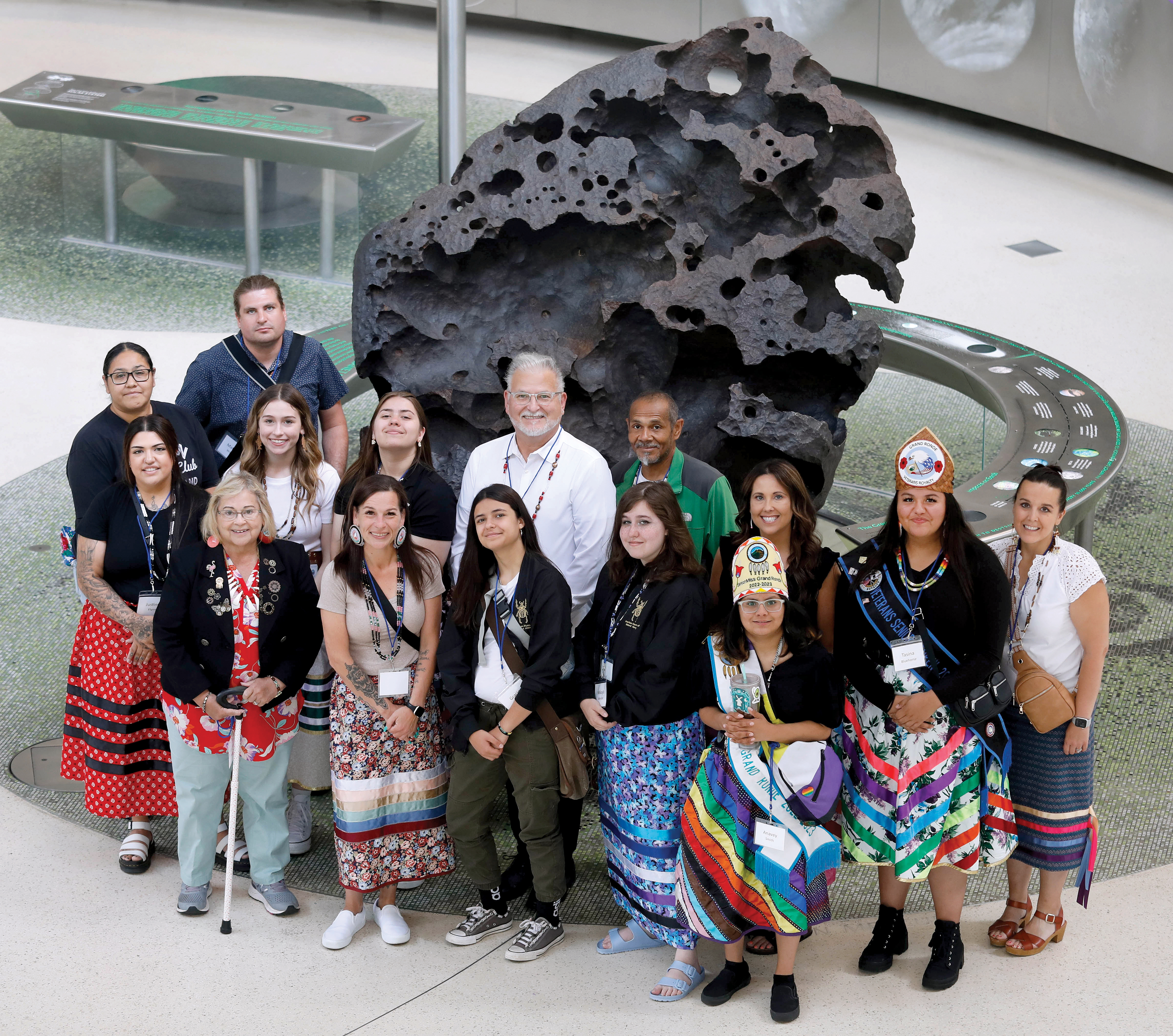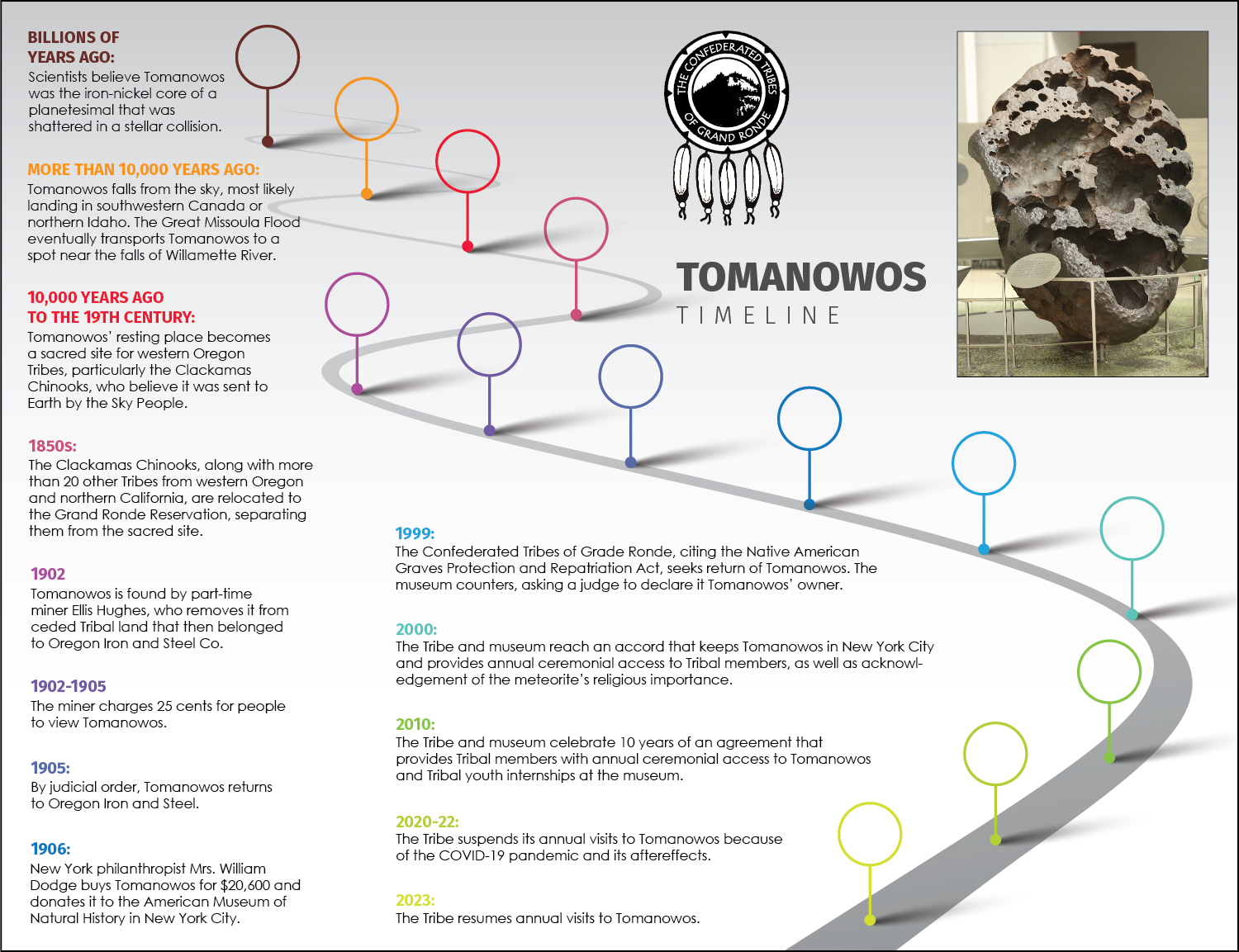Culture
Tribal members reconnect with Tomanowos after four-year pandemic pause

By Dean Rhodes
Publications Coordinator
NEW YORK CITY – The four years that passed since Grand Ronde Tribal members visited Tomanowos in New York City probably seemed like a blink of the eye for the meteorite that is as old as the solar system itself – 4.6 billion years give or take a few months.
But for Grand Ronde Tribal members, the pandemic-caused pause in visiting the sacred object lasted for what seemed like forever.
On Thursday, June 29, Tribal members reconnected with Tomanowos during a private and confidential ceremony held in the American Museum of Natural History adjacent to Central Park.
The Tribal contingent was led by Tribal Council member Jon A. George and Elders Sue Ann Suderman and Marcel Allen. Tribal members who are also employees included Communications Manager Sara Thompson, Multimedia Specialist Matthew Williams, Member Services Manager Shannon Simi, Social Media/Digital Journalist Kamiah Koch, Tribal Council Administrative Assistant Shannon Ham-Texeira, Public Works Coordinator John Mercier and Records Clerk Hollie Mercier.
Tribal member attendees included Tribal Elder Simone Auger, Tribal Royalty members Tasina Bluehorse and Anavey Smith, Spencer Weiss, museum interns Hattie Mercier, Gracie Mercier, Mikayla Mercier and Kaleigha Simi and their chaperones, Cultural Education Specialist Cristina Lara and Curriculum and Professional Development Program Manager Justine Flynn.
The annual Tribal ceremony with Tomanowos, the first since 2019 because of the COVID-19 pandemic, was led by Lara in the Frederick and Sandra Priest Rose Center for Earth & Space. She requested that the details of the 90-minute event remain confidential.
Smoke Signals staff in attendance included Publications Coordinator Dean Rhodes, photojournalist Michelle Alaimo and Koch. Also attending were Rhodes' wife, Patricia, and three employees of the museum.
Tomanowos’ history
Tomanowos is the iron-nickel core of an early planetoid that was formed and orbited the Sun millions of years ago. After that planet was shattered, perhaps in a collision with another proto-planet, the core fell at approximately 40,000 miles per hour to the Earth’s surface, landing somewhere in southwestern Canada.
The meteorite eventually found its way to present-day West Linn in the Willamette Valley as a passenger in the Missoula Floods that carved out the Columbia River Gorge. The Clackamas Chinooks named it Tomanowos and revered it as a spiritual being that healed and empowered the people since the beginning of time. The rainwater that collected in the meteorite’s crevices and pockmarks served as a powerful purifying, cleansing and healing source for the Clackamas and their neighbors.
Tribal ancestors also dipped their spearheads into the crevices and pockmarks of Tomanowos to obtain spiritual strength before a hunt.
But the Native connection was broken when the Clackamas and other Tribes were removed from the West Linn area and relocated to the Grand Ronde Reservation in the 1850s.
With the Native peoples gone, Tomanowos’ story grew more complex and convoluted. In 1902, it was kidnapped by part-time miner Ellis Hughes, who moved it off land owned by Oregon Iron and Steel Co., and he charged people 25 cents to view it.
Eventually, Oregon Iron and Steel won a lawsuit to regain ownership of the meteorite, which was then purchased in the early 20th century by a wealthy New York City philanthropist who moved it across the country and donated it to the American Museum of Natural History, where it sat, waiting patiently for almost 100 years for its Native peoples to find it.
In 1999, the Grand Ronde Tribe submitted a claim to the museum seeking return of Tomanowos under the provisions of the 1990 Native American Graves Protection and Repatriation Act. The museum countersued and eventually the two parties reached an agreement that Tomanowos would remain in New York City provided that Tribal members had annual access for religious ceremonies and the museum sponsored an internship program for Tribal youth to spend two to three weeks working at the museum every summer. This marks the 23rd year of that agreement.
As previously mentioned, those in-person visits and the internships were suspended in 2020, 2021 and 2022 because of the COVID-19 pandemic.
Museum breakfast
On Thursday, June 29, museum staff held a breakfast in the Mignone Halls of Gems and Minerals for the Grand Ronde delegation.
Museum Director Lisa Gugenheim welcomed Tribal members.
“This marks the 20th delegation that we’ve been able to welcome here at the museum,” Gugenheim said. “It’s always very, very meaningful to bring together the Tribal community, Elders, council members, chaperones and interns with our museum community for the first time in four years.”
Museum President Sean Decatur spoke about how the museum is working with Native communities regarding items in its collections and how they are displayed to the public.
“This is a season for renewal in many ways as we all emerge from the difficult pandemic years,” Decatur said. “It’s a time of renewal for the partnership between Grand Ronde and the museum. We’re very grateful for this opportunity.
“We’re living in an important time, a time that is actually appallingly overdue in many ways, when institutions like this one, across the country and around the world are reckoning with their histories and with practices that have affected and damaged Native people, Native communities and treasured objects, traditions and knowledge. Like many other institutions right now, we are working to acknowledge our museum’s own history with an intention of forthrightness, humility and a desire to learn. This work includes working with Native communities to improve the way their cultures are represented in our halls and programs.”
George spoke and gifted 14 dentalium necklaces to museum employees.
“We have this connection from one coast to the other coast,” George said. “But I speak more highly of friendships, of how we gather together to work together.”
Suderman, granddaughter of Clara Riggs, displayed mementoes she brought along on the trip, including hawk feathers, and told two stories. Then the four interns took turns discussing their shared experiences while working at the museum.
The interns discussed the diversity of New York City, pigeons, the culture shock of going from a small town to a large city and how the experience has deepened their individual connections with Tomanowos.

 Tribal Elder Marcel Allen, left, and Tribal member and American Museum of Natural History intern Hattie Mercier look at an artifact from a Double Ball game during a behind-the-scenes tour of Native American archives at the New York City museum on Thursday, June 29. (Photo by Michelle Alaimo/Smoke Signals)
Tribal Elder Marcel Allen, left, and Tribal member and American Museum of Natural History intern Hattie Mercier look at an artifact from a Double Ball game during a behind-the-scenes tour of Native American archives at the New York City museum on Thursday, June 29. (Photo by Michelle Alaimo/Smoke Signals)
Following the breakfast, Grand Ronde Tribal members received a behind-the-scenes tour of the museum’s extensive Native American textile archives led by Paul Beelitz, director emeritus of Collections and Archives in the Division of Anthropology, and Lauri Halderman, vice president of Exhibitions, led a tour of the Northwest Coast Hall.
The hall features a cedar and clam shell hat made by Tribal member Carol Colton and donated by Joanne Colton-Comeaux.
“Over these 23 years, this agreement that we have has become a model for our work,” Gugenheim said as she wrapped up the breakfast. “Reciprocal relationships, welcoming one another. I’ve had the privilege of being welcomed in the community, and being able to welcome you here today. These two weeks have been a privilege for us all.”
In addition to the Tomanowos activities, Tribal members and employees also visited the Statue of Liberty, the Metropolitan Museum of Art and caught the Broadway show “Wicked” on Friday, June 30, as well as squeezed in some shopping at the Lego and Harry Potter stores.
The Tribal contingent returned to Oregon on Saturday, July 1.
 Graphic by Samuel Briggs III/Smoke Signals
Graphic by Samuel Briggs III/Smoke Signals
